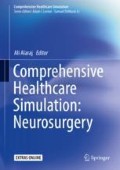Abstract
Reduced number of working hours for residents and the trend toward minimal or even noninvasive treatment of cerebral aneurysms have resulted in residents’ decreased exposure to live surgery in the operating room. This decrease becomes increasingly relevant when surgeons encounter complications, especially vascular injuries and intraoperative rupture of aneurysms, after completion of their training, neurosurgery residents will face complicated cases and intraoperative aneurysmal rupture in their practice while they are on their own, and to develop competency in managing cerebral aneurysms, laboratory training will be the compensation mechanism to cover the decreased hands-on experience in the OR. In this chapter we will describe a more realistic aneurysm model, which allows repetitive training under lifelike conditions for residents and other trainees to practice surgical clipping of cerebral aneurysms.
Artificial aneurysms were created in the usual locations of the cerebral vasculature of human cadaveric head specimens to train residents and neurosurgeons in the practice of surgical clipping of cerebral aneurysms and the management of complications associated with intraoperative aneurysmal rupture. Specimens were specially prepared for this technique and connected to a pump that blood simulant into the vessels. This setting created a situation in the cadaver which simulated live surgery in terms of bleeding, pulsation, and softness of tissue.
Neurosurgical residents were able to practice aneurysmal clipping and management of intraoperative rupture in a lifelike surgical environment and at the same human anatomy.
Access this chapter
Tax calculation will be finalised at checkout
Purchases are for personal use only
References
Liu A, Huang J. Treatment of intracranial aneurysms: clipping versus coiling. Curr Cardiol Rep. 2015;17(9):628.
Batjer H, Samson D. Intraoperative aneurysmal rupture: incidence, outcome, and suggestions for surgical management. Neurosurgery. 1986;18:701–7.
Batjer H: Comment on Lawton MT, Du R: Effect of the neurosurgeon’s surgical experience on outcomes from intraoperative aneurysmal rupture. Neurosurgery. 2005;57:9–15.
Chowdhry SA, Spetzler RF. Genealogy of training in vascular neurosurgery. Neurosurgery. 2014;74(Suppl 1):S1989–203.
Yasargil MG. Microneurosurgery, vol. I. New York: Thieme Stratton; 1984. p. 6.
Alaraj A, Luciano CJ, Bailey DP, Elsenousi A, Roitberg BZ, Bernardo A, Banerjee PP, Charbel FT. Virtual reality cerebral aneurysm clipping simulation with real-time haptic feedback. Neurosurgery. 2015;11(Suppl 2):52–8.
Singh H, Kalani M, Acosta-Torres S, El Ahmadieh TY, Loya J, Ganju A. History of simulation in medicine: from Resusci Annie to the Ann Myers Medical Center. Neurosurgery. 2013;73(Suppl 1):9–14.
Mori K, Yamamoto T, Nakao Y, Esaki T. Development of artificial cranial base model with soft tissues for practical education: technical note. Neurosurgery. 2010;66(6 Suppl Operative):339–41.
Aboud E, Al-Mefty O, Yasargil MG. New laboratory model for neurosurgical training that simulates live surgery. J Neurosurg. 2002;97:1367–72.
Aboud E, Aboud G, Al-Mefty O, Aboud T, Rammos S, Abolfotoh M, Hsu SP, Koga S, Arthur A, Krisht A. “Live cadavers” for training in the management of intraoperative aneurysmal rupture. J Neurosurg. 2015;123(5):1339–46.
Reed AB, Crafton C, Giglia JS, Hutto JD. Back to basics: use of fresh cadavers in vascular surgery training. Surgery. 2009;146:757–62.
Jansen S, Cowie M, Linehan J, Hamdorf JM. Fresh frozen cadaver workshops for advanced vascular surgical training. ANZ J Surg. 2014;84(11):877–80.
Mitchell EL, Sevdalis N, Arora S, Azarbal AF, Liem TK, Landry GJ, Moneta GL. A fresh cadaver laboratory to conceptualize troublesome anatomic relationships in vascular surgery. J Vasc Surg. 2012;55(4):1187–94.
Benet A, Plata-Bello J, Abla AA, Acevedo-Bolton G, Saloner D, Lawton MT. Implantation of 3D-printed patient-specific aneurysm models into cadaveric specimens: a new training paradigm to allow for improvements in cerebrovascular surgery and research. Biomed Res Int. 2015;2015:939387.
Anastakis DJ, Regehr G, Reznick RK, et al. Assessment of technical skills transfer from the bench training model to the human model. Am J Surg. 1999;177:167–70.
Benet A, Rincon-Torroella J, Lawton MT, S’anchez JJG. Novel embalming solution for neurosurgical simulation in cadavers: laboratory investigation. J Neurosurg. 2014;120(5):1229–37.
Anderson SD. Practical light embalming technique for use in the surgical fresh tissue dissection laboratory. Clin Anat. 2006;19:8–11.
Aboud ET. Method and apparatus for surgical training. U S Patent No US 6,790,043. Sep 2004.
Aboud ET, Krisht AF, O’Keeffe T, Nader R, Hassan M, Stevens CM, et al. Novel simulation for training trauma surgeons. J Trauma. 2011;71:1484–90.
Aboud ET, Aboud G, Aboud T. “Live cadavers” for practicing airway management. Mil Med. 2015;180(3 Suppl):165–70.
Acknowledgments
We thank Ronalda Williams for her editorial assistance and Ron Tribell for his artistic work.
Author information
Authors and Affiliations
Corresponding author
Editor information
Editors and Affiliations
Electronic Supplementary Material
Shows creation of pseudoaneurysms and clipping exercises (MP4 192738 kb)
Demonstrates practicing the managemen t of intraoperative aneurysmal rupture (MP4 166932 kb)
Other training procedures and different applications of the live cadaver model (MP4 318978 kb)
Rights and permissions
Copyright information
© 2018 Springer International Publishing AG, part of Springer Nature
About this chapter
Cite this chapter
Aboud, E. et al. (2018). Pseudoaneurysm Surgery Simulation Using the “Live Cadaver” Model for Neurosurgical Education. In: Alaraj, A. (eds) Comprehensive Healthcare Simulation: Neurosurgery. Comprehensive Healthcare Simulation. Springer, Cham. https://doi.org/10.1007/978-3-319-75583-0_8
Download citation
DOI: https://doi.org/10.1007/978-3-319-75583-0_8
Published:
Publisher Name: Springer, Cham
Print ISBN: 978-3-319-75582-3
Online ISBN: 978-3-319-75583-0
eBook Packages: MedicineMedicine (R0)

